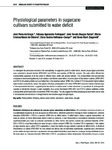Please use this identifier to cite or link to this item:
http://www.alice.cnptia.embrapa.br/alice/handle/doc/870391| Title: | Physiological parameters in sugarcane cultivars submitted to water deficit. |
| Authors: | GRAÇA, J. P. da  RODRIGUES, F. A.   FARIAS, J. R. B.   OLIVEIRA, M. C. N. de   HOFFMANN-CAMPO, C. B.   ZINGARETTI, S. M.   |
| Affiliation: | JOSÉ PEREZ DA GRAÇA, UNESP Jaboticabal; FABIANA APARECIDA RODRIGUES, CNPSo; JOSE RENATO BOUCAS FARIAS, CNPSO; MARIA CRISTINA NEVES DE OLIVEIRA, CNPSO; CLARA BEATRIZ HOFFMANN CAMPO, CNPSO; SONIA MARLI ZINGARETTI, Universidade de Ribeirão Preto. |
| Date Issued: | 2010 |
| Citation: | Brazilian Journal of Plant Physiology, Londrina, v. 22, n. 3, p. 189-197, 2010. |
| Description: | CONTEÚDO: To investigate the processes involved in the susceptibility of sugarcane plants to water deficit, several physiological parameters were evaluated in drought tolerant (SP83-2847 and CTC15) and sensitive (SP86-155) cultivars. The water deficit affected the photosynthetic apparatus of all the plants in different ways, within and among cultivars. The photosynthetic rate and stomatal conductance decreased significantly in all cultivars submitted to water deficit. In control plants of the tolerant cultivars (SP83-2847 and CTC15) the photosynthetic rate was higher than in the sensitive cultivar (SP86-155). Cultivar CTC15 showed the highest relative water content during the dry period. The quantum efficiency photosystem II of cultivar SP83-2847 was more stable in the last days of the experimental treatment, suggesting that the decline in relative water content stimulated an adjustment of photosynthetic capacity to tolerate the changes in water availability. As a whole, the tolerant SP83-2847 and CTC15 cultivars exhibited a better photosynthetic performance than the sensitive SP86-155 cultivar. The data suggest that these physiological parameters can be used in the evaluation and distinction of drought tolerant and sensitive sugarcane genotypes. ABSTRACT: Parâmetros fisiológicos de cultivares de cana-de-açúcar submetidas ao déficit hídrico. Para investigar o processo envolvido na susceptibilidade de plantas de cana-de-açúcar ao déficit hídrico, diferentes parâmetros fisiológicos foram avaliados em cultivares tolerantes (SP83-2847 e CTC15) e sensível (SP86-155) ao déficit hídrico. O déficit hídrico afetou o aparato fotossintético de todas as plantas de forma diferenciada dentro e entre as cultivares. A taxa fotossintética e condutância estomática diminuíram significativamente para todas as cultivares submetidas ao déficit hídrico. Nas plantas controle das cultivares tolerantes (SP83- 2847 e CTC15) a taxa fotossintética foi maior do que a cultivar sensível (SP86-155). A cultivar CTC15 apresentou O teor relativo de água mostrou que a cultivar CTC15 apresentou o maior teor relativo de água durante o período de déficit hídrico. A eficiência fotossintética da cultivar SP83-2847 foi mais estável nos últimos dias do tratamento experimental, sugerindo que o decréscimo do teor relativo de água estimulou o ajustamento da capacidade fotossintética para tolerar as mudanças da disponibilidade hídrica. De modo geral, as cultivares tolerantes SP83-2847 e CTC15, apresentaram melhor desempenho fotossintético do que a cultivar Braz. J. Plant Physiol., 22(3): 189-197, 2010 190 j . p. gra ça et al. sensível SP86-155. Os dados permitem sugerir que tais parâmetros fisiológicos podem ser usados na avaliação e distinção de genótipos de cana-de-açúcar tolerantes e sensíveis ao déficit hídrico. |
| Thesagro: | Deficiência hídrica Cana de acucar Producao vegetal |
| NAL Thesaurus: | Water stress Agriculture |
| Keywords: | Saccharum spp |
| ISSN: | 1677-9452 |
| DOI: | 10.1590/S1677-04202010000300006 |
| Type of Material: | Artigo de periódico |
| Access: | openAccess |
| Appears in Collections: | Artigo em periódico indexado (CNPSO)  |
Files in This Item:
| File | Description | Size | Format | |
|---|---|---|---|---|
| v22n3a061.pdf | 315,02 kB | Adobe PDF |  View/Open |









